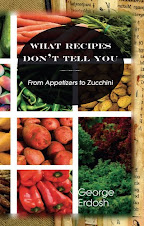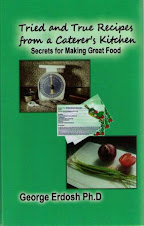Cilantro

Monday, August 31, 2015
EGGPLANTS FOR DINNER
Eggplants have tiny air-holes throughout just like sponges
have. In the kitchen, that’s good, these little holes absorb and retain flavors.
But they also soak up oil when fried and even more so if you fry eggplant
slices at incorrect temperature.
Usual ideal frying temperature is 375 degrees at which
temperature there is enough outward pressure of steam generated within the
eggplant to keep much of the oil out. If you fry them at much higher
temperature, the eggplant slices will burn outside and not get cooked inside.
Coating with breading also tends to reduce the amount of absorbed oil.
Even though fried eggplant is wonderful I rarely fry
them. Frying is a messy kitchen project and, like most of us, I try to keep rich
oily foods away from the dinner table. If I need fried eggplant slices for a
recipe (like moussaka), I brush oil on both sides of the eggplant slices and
brown them in hot 450-degree oven until they
get a nice brownish color.
I often use either one of two methods to serve eggplant.
If I am planning to grill on the barbecue, I cut thick eggplant slices, brush
both sides with vegetable or olive oil and place these directly on the hot
grill. After about 6 minutes it’s time to turn them over to brown the second
slice.
If I don’t use the grill, I bread thick eggplant slices
dipping them in beaten eggs and breadcrumbs (I omit the flour since eggplants
are pretty dry), brush both sides with oil, sprinkle with salt and bake in 450-degree
oven for about 30 minutes, flipping slices over halfway through.
Many recipes call for salting eggplant slices for an hour
to draw out extra moisture. This is no longer necessary. Eggplants used to have
a bitterish component that salting drew out but in today’s eggplant hybrids
that’s no longer true. You save an extra unnecessary step by omitting this.
Thursday, August 27, 2015
GARLIC--PREPARE PLENTY AHEAD OF NEED
I used plenty of garlic in my kitchen and I want to have
them available ready to use in cooking or on salads. I don’t like to chop them
by individual cloves any time garlic is needed.
I prefer to spend about 20 minutes every five or six
months and have chopped garlic on hand.
I buy about five heads and prepare the entire batch in
one sitting. I have a fist-sized smooth river rock I use to crush each head
with a few good bangs, separating the cloves. Next I whack each clove with the
stone with enough force to squash it, thus make peeling the husk easy.
While doing this, I have two little bowls on my work
surface, one with water to dip my fingers in when they get too sticky from the
garlic juice (this juice is water soluble). In the second bowl I accumulate the
peeled garlic cloves. This process takes about 15 minutes. The rest is easy.
I add the garlic into the bowl of the food processor and
let the blade crush the garlic for a few second. Then scrape down the side of
the bowl and repeat processing the garlic one or two more times, pulsing the
processor.
I cut about 5x5 inch squares of a plastic wrap and on
each square I place 3 to 4 tablespoons crushed garlic. I wrap each tightly, and
place them in a tight-fitting container ready for the freezer. I keep one small
container of crushed garlic in another small container for everyday use. I try
to remember to replenish from the freezer container whenever the garlic gets
low in the refrigerator.
Tuesday, August 25, 2015
STUFFED PEPPERS IN TOMATO SAUCE
Every year in midsummer I look forward to one of my favorite
dishes: stuffed peppers in tomato sauce. My mother made it several times during
the summer season and she insisted using fresh, local peppers from the farmers’
market. I do the same. I am fortunate to have a large, not too distant farm-stand
filled with seasonal produce.
Over the years they became too successful as a result of
their fabulous corn know all over the region so they extended their display to
bring in non-seasonal produce (like bananas and lime) and add other farmers’
crop on consignment—crops they don’t grown themselves. I disregard those and restrict
my pick to whatever they grow. I don’t know how they do it but most of their
crops have no equal in freshness, in their wholesome appearance and flavor.
To me, three items are exceptional on their stands: corn,
bell peppers and cantaloupes. I take advantage of all three. Their bell peppers
are huge: close to half a pound each and full of flavor. I select the ones that
started to develop reddish streaks indicating they are beginning to ripen and
now they have especially great flavor. I disregard the red peppers displayed
next to the greens that are grown for color in salads—they don’t have the
flavor of the green bells.
For stuffing the peppers I stop at the local butcher. He
has mixture of ground pork, beef and veal in frozen one-pound packages. They
are reasonably low in fat and found them to be by far the best in flavor unless
I am willing to grind my own ground meat mix.
For the tomato sauce I have two choices: using fresh
tomatoes whenever I can get good flavorful ripe ones or canned tomatoes and
tomato paste whenever I cannot. Here is my stuffed pepper recipe, basically the
same as that my mother made but slightly updated. Here I am using canned tomato
paste (very convenient). Note the use of plenty of paprika; that attests to this dish's Hungarian heritage.
Stuffed Peppers
6 bell peppers, top
cut off and seeds and membranes removed
Sauce
4½ cups tomato sauce (11 oz paste + 24 oz
water)
¾ tsp salt
4 tsp sugar
medium roux
made with 4 Tbsp flour and 4 Tbsp vegetable oil
Stuffing
½ lb ground beef
½ lb ground pork
(or ⅓ lb each of pork, beef and veal)
1½ oz bacon, chopped
and fried crisp
4 oz onion,
lightly browned in bacon drippings
1 egg
½ cup uncooked white
long-grain rice
1½ tsp salt
1 tsp black pepper
1 Tbsp paprika
½ tsp ground chili
4 Tbsp parsley,
chopped
To make sauce,
prepare roux by browning 4 Tbsp flour on 4 Tbsp vegetable oil, stirring
constantly on low heat until beginning to turn color, about 4 minutes. Stir a
few spoonfuls of sauce into the roux, and add it to the rest of the sauce to thicken.
To make stuffing,
combine all stuffing ingredients. Spoon mixture into the peppers but don’t pack
too tight. Place them into sauce, bring it to a slow simmer and continue to
simmer for an hour on low heat, stirring often.
Serve with coarsely mashed plain potatoes with plenty of
sauce. You may serve extra sauce on the side.
Serves six.
Subscribe to:
Comments (Atom)






 Stumble It!
Stumble It!










